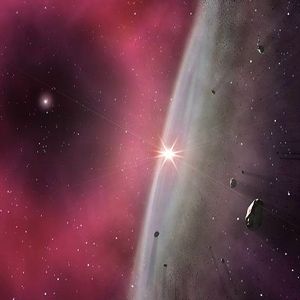
The findings challenge the theory that radioactive isotopes trapped in meteorites from the dawn of our Solar System originated in a supernova. They also shed light on the origins of water on Earth, says a study in the journal Meteoritics and Planetary Science, and may help astronomers predict how common water is on other planets.
"In the past, most people have been convinced that the radioactive isotopes present in the young Solar System must have come from a supernova," said co-author Maria Lugaro, an astrophysicist from Monash University in Melbourne.
Stellar winds
"What we have shown is that that dying stars of lower masses, shedding material into their surroundings via strong winds, actually better match the meteoritic signature of these radioactive nuclei," she said.
Scientists have known for over 40 years that meteorites - made of rocks formed during the birth of the Solar System - contained radioactive material. Commonly thought to have been spewed into space by a spectacular cosmic explosion known as a supernova, this material polluted the gas from which these rocks formed.
The supernova theory is problematic, though, say some experts.
Firstly, stars that die as supernovae are very rare and massive - at least 10 times the size of our own Sun. Secondly, models of the types of radioactive isotopes produced by supernovae don't quite match the types of isotopes found in the meteorites.
Red giants
Although closely matching the meteoritic levels of aluminium-26 and iron-60, supernovae are predicted to produce too much manganese-55.
Lugaro and colleagues suspected this is because a different kind of dying star, known as a red giant, is responsible for the radioactive material. Red giants are much smaller - sometimes with less mass than our Sun - and are much more common than the massive stars that create supernovae.
To test their theory, telescopes were used to record the emissions from red giants as they were dying. Spectral measurements from these telescopes were then used to validate a theoretical computer model of star evolution, composition and death.
The new model showed that a red giant with a mass of around six times that of the Sun creates radioactive material in proportions that more closely match those found in meteorites. "Our proposed star produces aluminium-26 and iron-60, but no manganese-55, so it performs better with respect to the meteoritic observations," Lugaro told Cosmos Online.
She is quick to note that more research is needed. "What we need to do now is investigate the probability that a dying giant star could have actually been nearby our then young Solar System and polluted it with radioactive nuclei.
Early environment
"This will inform us about the environment in which the Solar System was born, about the probability that other young planetary systems are also polluted with radioactive nuclei, and, eventually, on the probability of having water on terrestrial planets in other planetary systems," Lugaro said.
It's possible that without this radioactive material, Earth's water would not exist. This is because water was delivered by water-containing rocks, which formed far away from the Sun. The decay of radioactive nuclei in these rocks is thought to have led to the correct temperatures for water to form.
Trevor Ireland, a geochemist from the Australian National University in Canberra, finds the study convincing.
"Short lived radioactive particles are the smoking gun of fresh input to the Solar System shortly before it formed. This work suggests that many of these radioactive particles can be produced in the right proportions... by a massive red giant phase star," he said.



Does not this suggest our solar system is just the latest version; that there was another system occupying this space before ours?